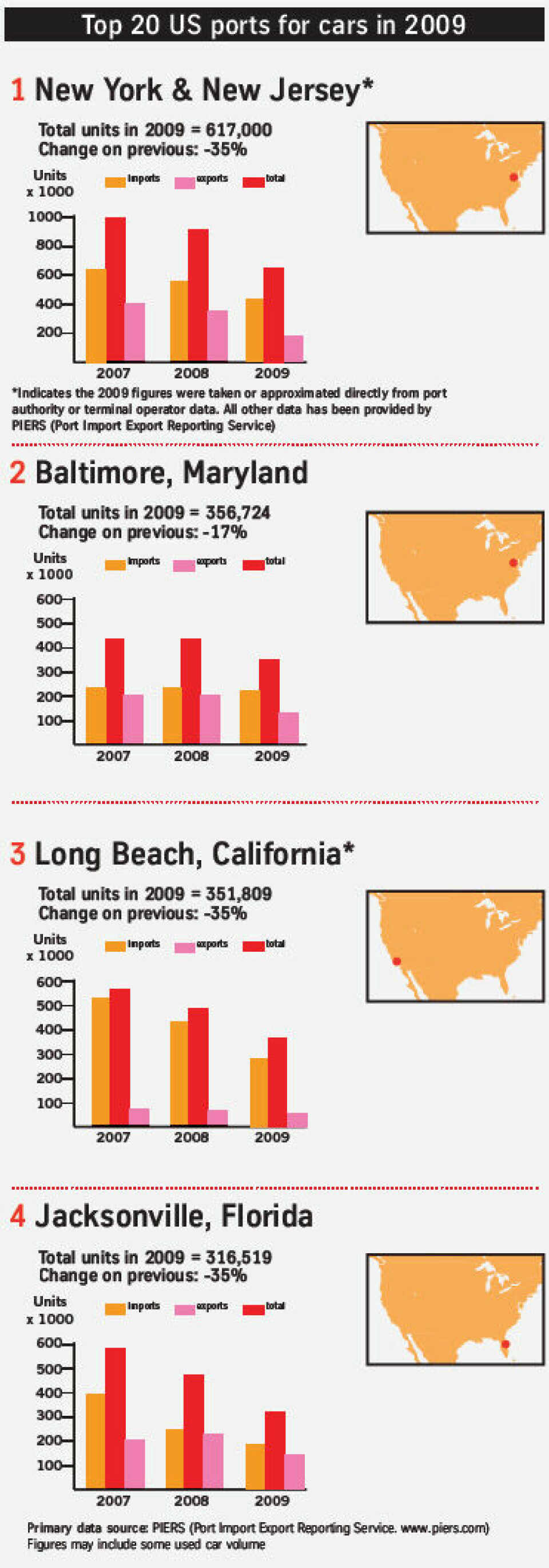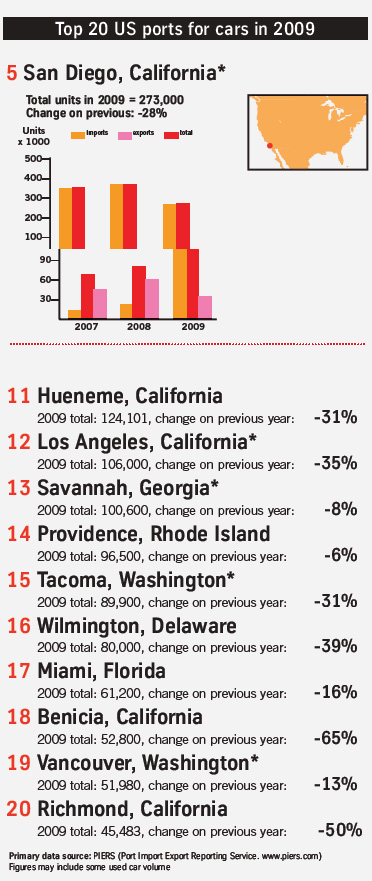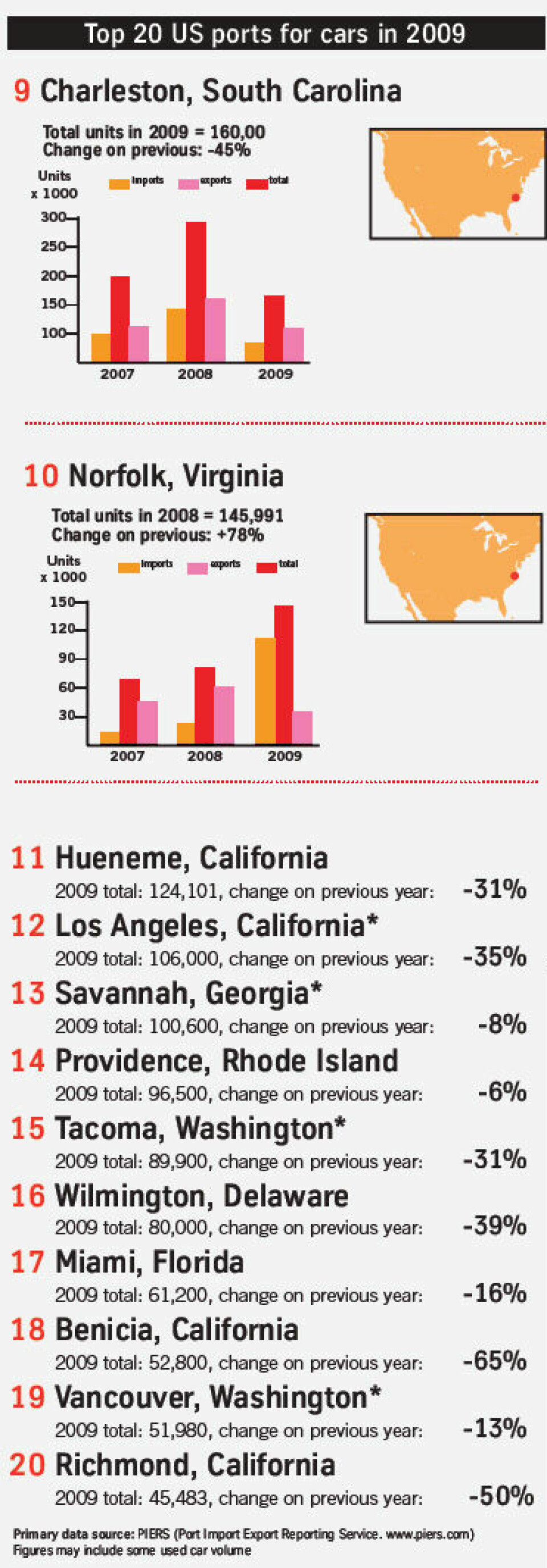Stop hanging around

Who you sell to still dictates carmakers’ choice of ports but patterns are shifting, and US ports try to keep pace with the trend to keep cars moving ever quicker along the supply chain, says Chris Lewis.
Red wine stored in the cellar may improve with age–new cars held in stock most certainly do not. Dennis Manns sees his task at American Honda as ensuring that the company’s assets never get the chance to “mature” by sitting around needlessly in parking lots, or on docksides. “Essentially, our business model is simple–we build it and we ship it. It’s about closing the gaps in the process. If a car is sitting there, it’s not making money for us.” A year ago, Honda did have a lot of unsold cars and it hurt. “That was millions of dollars tied up,” he recalls. But the signs are now that the market is picking up again quite strongly. Honda is celebrating this re-emergence with a brand new port operation at Richmond, California–not far from the major port of Oakland and the city of San Francisco.
The development was in the planning for three to four years, before the recession began to bite, but the fact that it is coming on-stream now is quite opportune. It complements existing Honda port operations at Portland, Oregon in the northwest US and National City, near San Diego and the Mexican border. “Adding a third port will give us greater flexibility and also help us in our goal of reducing our truck-miles by one million a year,” explains Manns. Richmond is in the heart of the northern Californian market and is a hub for cars made in Honda’s US and Mexican plants, allowing them to make a large part of the journey across America by rail. Hyundai and Kia used Richmond until about six months ago; Honda itself used the port many years ago. It’s an attractive location, says Manns, not only because its location allowed Honda to assemble a 35-acre contiguous piece of land, but also the helpful attitude from the city planning department and local government.

Getting in and getting out…fast
What makes a good carport? “Obviously land is a big issue as auto ports take up a lot of space. If you possibly can, you want to avoid shuttling between different areas. And you also need great rail and marine access. And having in and out direct access to the highway is also very important,” says Manns. A big piece of land comes in handy for new model launches when it is necessary to stage product so that it can hit all the nation’s dealers simultaneously. Even in a country as big as the US, finding enough space with all the right attributes can be tricky, and Richmond fitted the bill.
Bill Robbins of TransDevelopment Group, a company that specialises in building and designing cargo facilities, says that the new Richmond facility was still under development but received its first shipment of Hondas in mid-April. He explains: “This is a major project that we have worked on for four years with Honda, which supported it during the worst recession we have seen.”
The new terminal would help speed up shipments of cars into locations like Texas compared with the long voyage through the Panama Canal by allowing cars to be offloaded on the West Coast and then railed to destination. “It costs more money, but it’s much quicker, and car manufacturers want to increase velocity to destination.” Historically, Honda and Toyota have run pretty lean supply chains, but now other manufacturers, like Kia, are looking at a similar approach. The terminal is able to handle cars, although construction was expected to continue for about another two months. “Right now, we have to shuttle vehicles to an older rail yard, but when we finish there will be a railhead right into the port.” TransDevelopment is currently working on several other plans for ports, adds Robbins. Common themes at the moment are the desire to cut stock, increase velocity and also gain “neutrality” with regard to railway service. “If operators are making long-term commitments to a port facility, they want to be sure that there is not going to be a railroad monopoly,” says Robbins. In other words, they want to be able to connect to any railway operator offering service to that region.

Chrysler-Fiat deal could nurture two-way flow
Chrysler has great hopes for its new alliance with Fiat, which could see an increase in Chryslers being sold in Europe. Likewise Fiat, never a major exporter to the US, could start to shift significant volumes into the US for the first time. All that is for the future, though, and head of worldwide vehicle transportation Steven Tripp’s more immediate concern is the US manufacturer’s new West Coast port at Gray’s Harbor, which replaced an existing operation at Port Hueneme from January this year. Chrysler has already substantially increased its exports to China and Southeast Asia and the new port will service these increased flows. While it’s a bit too early to say what the precise effect will be on Chrysler’s logistics flows, it would seem a fair bet that with Fiat taking over as Chrysler’s general distributor in Europe, more of its vehicles will be moving from east coast ports to Europe, where they will go into the Fiat network, says Tripp. “We’re working on a lot of new model launches at the moment,” he says.
Baltimore is currently Chrysler’s main east coast export port, with Jacksonville playing a supporting role mainly for the east coast of South America trade. Last year was a pretty dismal one, both at home in the US and abroad, says Tripp, “but now we are optimistic that there will be an uptick across the board.”
Chrysler’s existing ports should be able to cope with increased volumes, he says, especially now that the spacious Gray’s Harbor has taken over flows to the Far East. The port, he says, “offered a very attractive price and service offer overall, taking into account inland transport, processing, ocean transport and service frequency and transit times.”
Pasha Automotive Services has just started regular autohandling at Gray’s Harbor between Portland and Seattle. “We had been doing special projects there during the past oneand- a-half to two years including military cargo but now we have signed a three-year deal with Chrysler to export their product to China and Australia,” John Pasha explains. The terminal operator was looking for a new port operation because, says Pasha, “the port of Tacoma was, at the time, moving more to containers and we were looking for an extensive land area.” He believes that automotive will continue to be pushed out of more traditional ports. “Yes, at the moment ports are happy to handle anything, but in general they need the higher revenues that they can generate from containers to sustain themselves.” He estimates that boxes can produce four times more revenue per square foot of space than cars.

Steven Tripp adds that having an on-dock rail connection and dedicated terminal were important factors in Chrysler’s decision. “I wouldn’t go so far as to say that we’d avoid a port that handles significant numbers of containers, but it is important to have a dedicated auto terminal.” Other important factors are having space to park vehicles and a generally clean environment. Large amounts of dust from coal or iron ore wafting across the port area are definite no-nos.
Ports need to be meaner and leaner
John Felitto at WWL says that over the past five years the emphasis has been on integrating ocean, land transport and car and cargo processing activity. WWL serves a string of ports on both coasts of North America, and has numerous inland facilities, but the ports where it combines all its activities are Baltimore in the northeast, Brunswick in the southeast and on the west coast, Port Hueneme. Other important ports for WWL include Galveston and Vancouver–the latter currently more as a processing area than a port as far as WWL is concerned.
John Felitto adds that Manzanillo on the Gulf side of Panama is another up-and-coming location. While not in the US, it could be a useful place to store and maybe even process cars destined for US markets, before they have been allocated to specific regions. All WWL ships heading between the two coasts of the US pass through this point to go through the Panama Canal.
There has been a change of emphasis in the car industry since the recession took hold, says Felitto. “Volumes have picked up, but not to the extent of the peak in 2007 or 2008, and there’s now a much leaner, more responsive supply chain.” There is much more emphasis on precision, with online planning systems and tracking and control, so that manufacturers and dealers alike know precisely where cars are and when they will be delivered.
Grappling with recession
Ports all over the US are struggling with vastly reduced car volumes but there are signs that the worst is over and that limited growth is returning.
The Port of New York and New Jersey witnessed a sharp drop in its vehicle trade in 2009 over 2008. However, there were tentative signs of a recovery, at least in imports, towards the end of 2009–import volumes in the last three months of 2009 were roughly equal or slightly better than in the same months of 2008. In January 2010, volumes imports were slightly up in January 2010 compared with January 2009, at 40,457 compared with 39,950 in January 2008.
There are currently four major vehicle processors in the port–BMW operates its own 17-acre facility (which also handles Fiats); the 210-acre FAPS facility, which handles a variety of mainly European and Asian marques (although Hyundai-Kia have just left for Philadelphia) along with imports and exports of Chrysler, GMs and Fords; Toyota Logistics handles its own cars here, while the 90-acre Ports America site handles privately-owned vehicles.
Port spokesman Peter Zantal hopes that the improvement seen in import volumes in early 2010 will continue into the year. Domestic US car sales have improved, he says, and historically sales of imported vehicles have tracked them. “However, we are being a little bit more cautious at this time.” The port is also paying attention to the secondhand car trade. Many secondhand cars are containerised, but some are taken on the pure car and truck carriers and help balance the flow of trade for the vessel operators. The port handled around 111,000 TEUs (twenty-foot equivalent units) in 2009, compared with around 207,000 TEUs in 2008. (Up to 1.5 cars per TEU would be a fair measure of units handled.)
East coast is fiercely competitive
There is fierce competition for the East Coast trade and the nearby port of Philadelphia has signed a deal that will bring around 150,000 imported Hyundai and Kia cars every year. The Korean OEM is consolidating its East Coast operations, which had been in New York/New Jersey and Baltimore. The Port of Jacksonville (Jaxport) is predicting a 40% increase in its car throughput in the 2010 fiscal year compared with 2009. This would boost traffic closer to around 600,000 units, not far off the port record, according to Jaxport’s Roy Schleicher. He said the port could handle an extra 200,000 more vehicles a year by modifying its existing storage area at Blount Island.
Baltimore is one of the East Coast’s main car-handling ports and spokesman Rick Powers said Baltimore’s location was one of its key attractions, along with its service standards. “We’re around 150 miles further inland than all comparable East Coast ports and if you consider that it’s $5 more expensive to deliver each pound of freight an extra mile, our location is ideal.”
He also considers that Baltimore has some of the highest handling standards in the world. A quality handling team meets once a month, involving all the stakeholders including the OEMs, terminal operators, stevedores and the like to ensure that damage rates are continuously driven down. The latest quarter for which figures are available (January- March) suggests that volume is down by around 30% on the previous year but there are now signs of an improvement, says Rick Powers.
Less attractive than containers
While the major ports of the US do handle significant numbers of cars, the trend is generally towards specialist niche ports. Joel Valenzuela at the Port of San Diego, explains: “The success we’ve experienced has been due to the effective partnership between our operator, Pasha Automotive Services, and the port. It’s important that we as a port can give commitment, that they know that we’re not going to turn ourselves into, for instance, a container terminal.”
It can be difficult to find a port that is willing to commit itself long-term to the automotive trade. Quite simply, containers can be stacked on top of each other–cars cannot, except by resorting to expensive multi-storey garages. Automotive is often quite a small portion of many major ports’ total trade–hence the importance to the car industry of specialists like San Diego.
Freedom from congestion either on the landside or on the water is another important factor for car manufacturers who want to be able to predict precisely when shiploads of cars will arrive and when they will be on their way out of the dock gate by road or rail.
The port’s automotive trade has grown steadily since the partnership with Pasha started back in 1991, when 30,000 cars were handled. Traffic peaked at around 450,000 units in 2008 “when we were poised to do half a million the following year,” says Joel Valenzuela, before the world recession took its toll and business ebbed back. The first quarter of 2010 was indeed slightly higher than the corresponding period in 2009–58,000 as opposed to 56,543 units.
Big users of the port include Mazda, Honda, VW, Audi, Jaguar, Hyundai-Kia, Porsche, Lotus and Bentley, while the major shipping-line carriers include NYK, ACT Maritime, MOL and K Line.
How the West Coast compares
Elsewhere on the West Coast, the port of Los Angeles handled 106,000 vehicles in 2009, compared with 163,000 in 2008. The car terminal is operated by WWL at five berths on 85 acres, which handles the vast proportion of the traffic, which are mostly imports into the US. There is storage of up to 8,000 vehicles and there is an extensive rail yard for Union Pacific for the loading and unloading of auto racks. The primary customer is Nissan, for whom WWL also does extensive customisation work.
Art Wong, at the nearby Port of Long Beach reports that, for the first six months of the port’s fiscal year, which begin in October 2009, 117,570 vehicles were shipped through Long Beach, an increase of 6.96% from the same period a year ago. “But remember, the same period a year ago was when the world economy had just collapsed,” said Wong. However, he added, “Generally it seems pretty clear that the worst is behind us, and the question now is just how quickly we rebound.”





